Dirac and Feynman in One Box
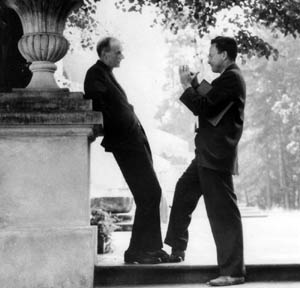
|
On this jubject, I published my first paper with Marilyn Noz in 1973. |
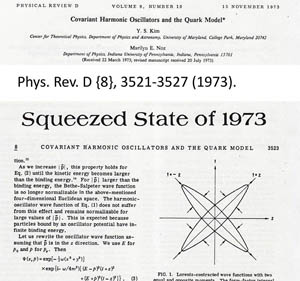
|
| |
|
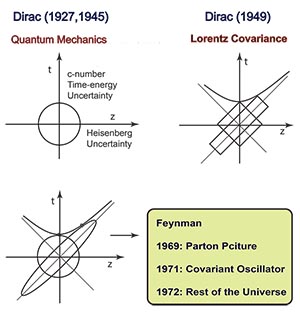
|
Click here a story. |
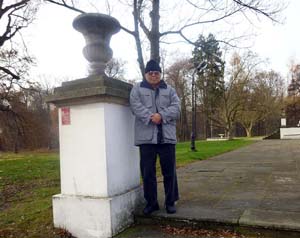
|
Dirac and Feynman met in 1962. |
-
Marek Holzman was a distinguished Polish photographer. In July of 1962, he
produced this historic photo during the relativity conference held in Warsaw.
This conference was organized by Leopold Infeld.
- More specifically, can Dirac's physics and Feynman's physics be put into
one box to generate a new understanding or the world? How?
Both Dirac and Feynman made their life-long efforts to combine quantum mechanics with special relativity. Both of them used harmonic oscillators when they developed new ideas.
- Dirac wanted to understand physics by constructing mathematics, while
Feynman started from what he observed in the real world. However
their papers had weak spots. Their major weakness is the lack of
figures.
You have read Dirac's book entitled "Principles of Quantum Mechanics" where he introduced bra and ket vectors. Dirac's articles are like poems. But they do not contain figures.
- Feynman used to give brilliant lectures. He invented Feynman
diagrams. Feynman was an established artist. He used to draw
pictures on napkins at night clubs when he saw exciting things.
However, he did not draw enough figures in his later papers. I
do not know what went wrong with him. Perhaps his age.
Like Feynman, I picked up the habit of drawing figures from John A. Wheeler. Feynman was Wheeler's thesis student at Princeton. Wheeler was not my advisor, but I was crazy enough to be remembered by him. Here is my Wheeler page. My advisor was Sam Treiman, who is known as Steven Weinberg's advisor.
- Yet, I am known in as Wigner's yougnest student in the physics world.
How did this happen? Click here for
a story. The point is that I started reading Wigner's 1939 paper when I
was a graduate student at Princeton (1958-61), but started understading
it only in 1978. In 1986, I published a book with Marilyn Noz on his paper.
Wigner's 1939 paper deals with the internal space-time symmetries
of particles in the Lorentz-covariant world. With this background,
I approached Wigner 1985, and started to telling him the stories
he wanted to hear.
- The following table shows how Dirac's papers and Feynman's papers
can integrated into one big paper. Their papers can be translated
into Wigner's language for the internal space-time symmetries of
particles in the Lorentz-covariant world.
Name of
PhysicistDirac Feynman
Means of
Expression
Mathematical Poems
Cartoons and Diagrams
Primary
Interest
Bound States,
Standing Waves
Scattering States,
Running Waves
Personality
Seldom talks to anyone.
Willing to join the crowd anywhere in the world.
Favorite tools of research
4-by-4 matrices,
Harmonic Oscillators
Path integrals,
Harmonic Oscillators
What they did
not see.
Their physics can be formulated within the framework of Wigner's representation theory.
- Click here for soft
spots in Dirac's papers and those in Feynman's papers.
- In Einstein's world, what problem are we dealing with?
- Click here for soft
spots in Dirac's papers and those in Feynman's papers.
Since then, this photo has been a great inspiration to many physicists. As you know, I am a harmony man. Is it possible to find a harmony between these two great physicists?
Paul A. M. Dirac
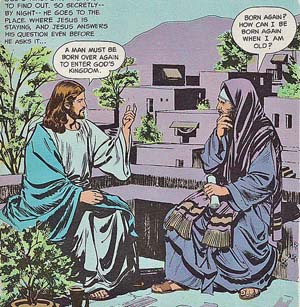
- In 1962, I was a first-year assistant professor at the University of
Maryland when Dirac came, and I had to provide convenience to him. While
I was alone with him, I asked him what the most important problem is in
American physics and what I should study. I asked this question because I
did not believe in what most of my colleagues were excited about at that time:
bootstraps, N/D methods, strip approximations, just about one new word
every week.
I was like Nicodemus who made a
secret visit to Jesus in order to find out about himself.
- Dirac's answer was that there are many things people do not understand about
Lorentz invariance and Lorentz covariance. He was not talking about
Chew or Mandelstam (headline makers at that time). I have been wondering
about who was the person he had in mind. Recently, after studying Dirac's
papers and Feynman's papers, I came to the conclusion that Dirac was talking
about Feynman, especially in view of the fact that he was talking to me two
months after he talked with Feynman as shown in
this photo.
In addition, Dirac was telling me to study his own papers. Here are
Dirac's papers which I studied in order to construct the
Dirac-Feynman box.
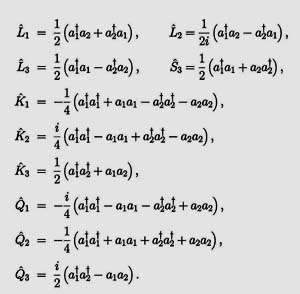
- P. A. M. Dirac,
The Quantum Theory of the Emission and Absorption of Radiation,
Proc. Roy. Soc. (London) A [114], 243 - 265 (1927).
- P. A. M. Dirac,
The Quantum Theory of the Emission and Absorption of Radiation,
Proc. Roy. Soc. (London) A [A183], 284 - 295 (1945).
- P. A. M. Dirac,
Forms of Relativistic Dynamics,
Rev. Mod. Phys. [21] 392 - 399 (1949).
- P. A. M. Dirac,
A Remarkable Representation of the 3 + 2 de Sitter Group,
J. Math. Phys. [4], 901 - 909 (1963).
- At that time, he was working on the two-oscillator representation of
the O(3,2) deSitter group, which later became the
mathematical basis for
two-mode squeezed states.
Click here for an interesting story.
Richard P. Feynman
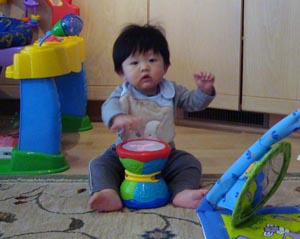
My grandson is imitating Feynman.
- Feynman's parton picture is one of his brilliant observations.
Yet, this is valid only in the infinite-momentum system and lacks
Lorentz covariance. Thus, it is fun to see whether the quark model
and the parton model are two different manifestations of
one Lorentz-covariant entity.
- In 1970, at the spring
meeting of the American Physical Society, Feynman gave a talk on the
quark model based on a Lorentz-covariant harmonic oscillator formalism.
Feynman talked about wave functions instead of Feynman diagrams. It was
a surprise talk to all of of us, but it was the most important event in
my life. Earlier, in 1966, I was thoroughly punished by some powerful
people for using wave functions in one of my Phys. Rev. papers.
Click here for the story.
Indeed, Feynman gave me enough strength to stand firmly against the wind.
I studied the following papers before putting them into the
Dirac-Feynman box.
- R. P. Feynman,
Phys. Rev. Lett. 23, 1415 - 1417 (1969);
R. P. Feynman, The Behavior of Hadron Collisions at Extreme
Energies , in High Energy Collisions, Proceedings of the Third
Topical Conference on High Energy Collisions of Hadrons, Stony Brook,
New York, edited by C. N. Yang
et al., Pages 237 - 249 (Gordon and Breach, New York, 1969).
- R. P. Feynman, M. Kislinger, and F. Ravndal,
Phys. Rev. D 3, 2706 -2732 (1971).
- R. P. Feynman, Statistical Mechanics
(Benjamin/Cummings, Reading, MA, 1972).
- Feynman Agenda.
This webpage explains how thos Feynman papers could be
coordinated.
Eugene P. Wigner
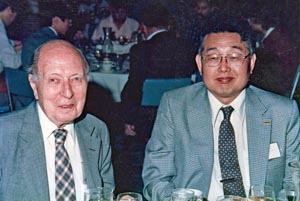
with Wigner (1986)
with Treiman (1987)

I met Eugene Wigner while I was a graduate student at Princeton
University. My thesis advisor was Sam Treiman. I wrote my thesis on dispersion relations
which every bright had to study at that time. While working on
my thesis, I had a question about the Lorentz covariance. I asked Wigner
about the Lorentz frame with a fixed four-momentum. He said there are three
degrees of freedom once the momentum is fixed. I did not realize
he was talking about
his 1939 paper on the little groups dictating the
internal space-time symmetries.
-
After 30 years, with Noz and Oh,
I published my first paper on the
representation of Wigner's little groups using harmonic oscillator wave
functions. I needed a wave function that can be Lorentz-boosted
in order to show that the quark model and the parton model are two different
manifestation of one covariant entity, as indicated in the third row of the
following table.
Further contents of Einstein's E = mc2
Massive/Slow
between
Massless/Fast
Energy
Momentum
E=p2/2m
Einstein's
E=(m2 + p2)1/2
E=p
Spin, Gauge,
Helicity
S3
S1
S2
Wigner's
Little Group
S3
Gauge Trans.
Internal
Space-time
Gell-Mann's
Quark Model
Covariant
Oscillators
Feynman's
Parton Picture
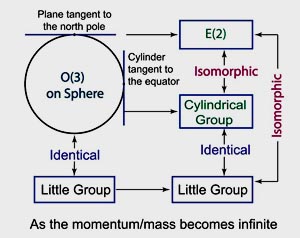
- In 1953, together with Inonu, Wigner published a paper on
group contractions.
Isaac Newton showed that a straight line tangential to a curve
can play an important role in physics. How about a tangential
plane on a curved surface. Inonu and Wigner addressed the question
of a plane tangent on the north-pole of a sphere. They showed how
the Galilean transformation emerges from the Lorentz transformation
in the limit if slow speed.
Here is a review paper by Inonu.
- Using this concept of group contractions, with Han and Kim in 1983,
I published a paper in the Phys. Lett. B showing that the transverse
rotational degrees become a gauge degree of freedom, as indicated
in the second row of the above table.
In 1986, with Marilyn Noz, I published a book entitled "Theory and
Applications of the Poincaré Group." We completed tha manuscript
in 1985. Here is
a review of the book.
- Indeed, by 1985, I was prepared to tell Professor Wigner the stories he
wanted to hear. I went to Princeton every two or three weeks to work
with Wigner, and we together published seven papers. This is the reason
why I am known as Wigner's youngest student.
- Symphony of Physics. Indeed, if
we combine Dirac, Feynman, and Wigner, the net result is a
physics symphony.

|
I was like Nicodemus who made a secret visit to Jesus in order to find out about himself.
In addition, Dirac was telling me to study his own papers. Here are Dirac's papers which I studied in order to construct the Dirac-Feynman box.
- P. A. M. Dirac,
The Quantum Theory of the Emission and Absorption of Radiation,
Proc. Roy. Soc. (London) A [114], 243 - 265 (1927).
- P. A. M. Dirac,
The Quantum Theory of the Emission and Absorption of Radiation,
Proc. Roy. Soc. (London) A [A183], 284 - 295 (1945).
- P. A. M. Dirac,
Forms of Relativistic Dynamics,
Rev. Mod. Phys. [21] 392 - 399 (1949).
- P. A. M. Dirac, A Remarkable Representation of the 3 + 2 de Sitter Group, J. Math. Phys. [4], 901 - 909 (1963).

|
Click here for an interesting story.

|
|
I studied the following papers before putting them into the Dirac-Feynman box.
- R. P. Feynman,
Phys. Rev. Lett. 23, 1415 - 1417 (1969);
R. P. Feynman, The Behavior of Hadron Collisions at Extreme Energies , in High Energy Collisions, Proceedings of the Third Topical Conference on High Energy Collisions of Hadrons, Stony Brook, New York, edited by C. N. Yang et al., Pages 237 - 249 (Gordon and Breach, New York, 1969). - R. P. Feynman, M. Kislinger, and F. Ravndal, Phys. Rev. D 3, 2706 -2732 (1971).
- R. P. Feynman, Statistical Mechanics
(Benjamin/Cummings, Reading, MA, 1972).

|
| with Wigner (1986) with Treiman (1987) |

|
I met Eugene Wigner while I was a graduate student at Princeton University. My thesis advisor was Sam Treiman. I wrote my thesis on dispersion relations which every bright had to study at that time. While working on my thesis, I had a question about the Lorentz covariance. I asked Wigner about the Lorentz frame with a fixed four-momentum. He said there are three degrees of freedom once the momentum is fixed. I did not realize he was talking about his 1939 paper on the little groups dictating the internal space-time symmetries.
|
Further contents of Einstein's E = mc2
| ||||
| ||||
| ||||
| ||||
|

|
In 1986, with Marilyn Noz, I published a book entitled "Theory and Applications of the Poincaré Group." We completed tha manuscript in 1985. Here is a review of the book.
- copyright@2014 by Y. S. Kim, unless otherwise specified.
The photo of Dirac and Feynman is from the Caltech Photo Archive. This photo was taken by Marek Holzman during the International Conference on Relativity Theory of Gravitation in Warsaw (Poland) on July 25-31 1962, organized by Leopold Infeld. The image of Jesus and Nicodemus is from "The Picture Bible" (David C. Cook Publishing Co., Elgin, Illinois, U.S.A., 1978).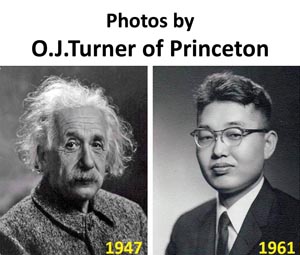
Why is he with Einstein? - Click here for Y. S. Kim's home page.